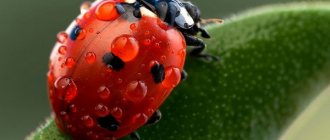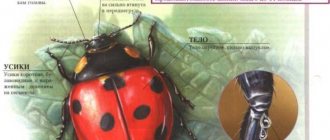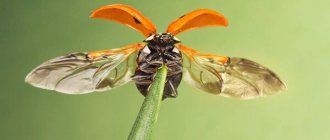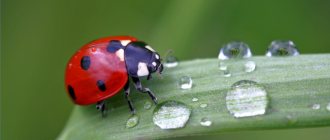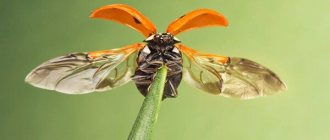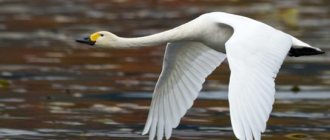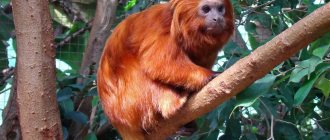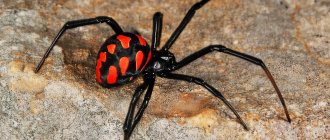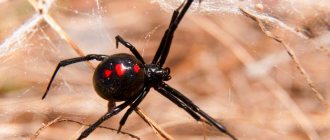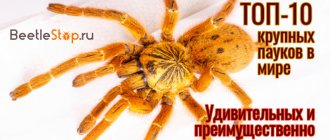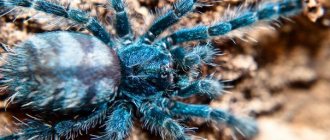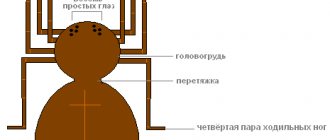Due to its coloring, the Argiope spider goes by such names as:
- wasp spider;
- zebra spider;
- tiger spider
However, its biological name is “Argiope Brünnich,” which the spider received in honor of a Dane named Morten Trane Brünnich, who lived back in the eighteenth and early nineteenth centuries and was at one time a very famous scientist in the field of zoology and mineralogy.
First, let's look at what argiope looks like in the photo.
What does an eresus spider look like: photo
Eresus: ladybug spider.
In the central part of the Russian Federation
The central part of Russia is characterized by pronounced seasonality. The climate is mostly humid and is not suitable for all arthropods. The following spiders are found here:
Silver spider
The only underwater representative of the world of spiders, the popular name is dropsy. Lives in bodies of water with standing water. The silverfish species are small spiders up to 15 mm in length, brown in color. Since dropsy is the only spider that is found on the surface of lakes and ponds, it cannot be confused with anyone else. If you disturb such a resident of a body of water, you may get a bite. Its venom is not dangerous to humans; the result of a bite is pain near the bitten area, which disappears in a few days.
Heiracanthium
Heiracanthium is the Latin name for the green spider in Russia. Popularly called sak or yellow-bag. The places where saka is distributed are Crimea, Krasnodar Territory, Rostov Region - it loves warm regions. Climate change is contributing to its emergence throughout the central part of the country.
The abdomen is yellow or beige, the cephalothorax is often orange, the green spider grows up to 15 mm. Its color appears green against the background of the leaves, hence the name. Sak builds web sacs and has the ability to jump. It has large chelicerae and poisonous claws; the yellowjacket bites painfully. The first sensations from a Heiracanthium sting are similar to those of a bee - a sharp, severe pain. The consequences can be different - from a long-healing wound to nausea and an allergic reaction. Depends on the age and health of the person.
Knitting spider
Popularly called the grandmother's spider. It often settles with a person, occupying corners of the apartment, cracks behind furniture, and weaves its “classic” web. It grows up to 1 cm, has a light brown color and an elongated abdomen on long legs. The knitter is absolutely harmless; when meeting a person, he prefers to pretend to be dead: fold his paws and sit motionless until the threat disappears.
Description of the Erasus spider
Name: Eresus or Black fathead Lat.:
Eresus kollariClass: Arachnida - Arachnida Order: Spiders - Araneae Family: Eresidae - Eresidae
| Habitats: | dry steppes and deserts |
| Dangerous for: | insects and small arachnids |
| Attitude towards people: | They don’t harm, but they bite painfully. |
Are you afraid of spiders?
TerribleNo
The size of the female individual is from 8 to 18 mm. The body is compact and round with short thick legs. The color is velvety black. Small light hairs are present. Males have a body length of 6 to 8 mm. The color is very bright. The cephalothorax is black with sparse light hairs. The hairs form the basis of white narrow rings.
The belly has a rounded shape. In the upper part it is painted bright red. In this area there are 4 black spots, similar in appearance to a button. The bottom and sides are black. The hind two pairs of paws may be spotted with red.
Biological characteristics
In official biological language, argiope belongs to the family of orb-weaving spiders. This family is characterized by the production of a large circular catch net with a pronounced spiral stabilimentum in the center. This section of the web is clearly visible in ultraviolet rays, which are distinguishable by many insects, and therefore the stablimentum is so attractive to various insects and beetles.
Reference! Stabilimentum - threads of the web that form a zigzag pattern.
Appearance
According to the description, the Argiope spider really looks like a wasp or a zebra. The body of the arthropod clearly shows an alternation of black and yellow stripes, however, this is characteristic only of females. Males of this species are small and inconspicuous.
Argiope Brünnich spiders exhibit pronounced dimorphism. The female has a body size of 15-30 millimeters in length, while the male Argiope barely reaches half a centimeter.
Spreading
This striped black and yellow spider mainly inhabits the middle and southern regions of Europe and Russia. But recently, thanks to climate warming, argiope has begun to be found in the northern regions. There is information that our spider was seen in the Moscow and Nizhny Novgorod regions, and even further north.
Lifestyle
The usual colony of Argiope settles in forests or meadows. where there is a massive number of potential casualties. The number of one settlement is usually about two dozen spiders.
A yellow striped spider weaves its webs in the twilight evening. He spends no more than one hour making his trap. After the web is woven, its owner is placed in the center of the network and, taking the shape of the letter "X", awaits the victim.
It should be noted that the Argiope catching net is very beautiful; it is distinguished by the presence of a pronounced circular shape and small cells, through which even the smallest mosquito cannot break through.
Nutrition
The zebra argiope spider feeds on the insects that fall into its web. These are mainly numerous Orthoptera, although various flies or mosquitoes often find themselves in the web. The spiders inject poison into them and entwine them with cobwebs, then they suck the juices from the victim’s body, which has begun to dissolve.
Reproduction
The female reaches the age of sexual reproduction after the last molt of her development. During mating, the female wraps a web around the male, and if he fails to get out, then his fate is unenviable - he will certainly be eaten.
And the female will then weave a large cocoon, into which she will place her numerous eggs, which she guards with the care of a loving mother.
At the beginning of autumn, the spiderlings emerge from the cocoon, and, being attached to the webs, are carried by the wind around the area, thus creating new colonies of spiders.
Attention! Flying webs during Indian summer, among other things, are a way for spiders to spread in open areas.
In other cases, the female can lay eggs, and there are up to a hundred of them in one cocoon, in late autumn, and the young spiders hatch and settle with the arrival of spring. The female herself does not overwinter, but, having laid eggs, dies.
Diet and lifestyle
The Eresus spider leads a secretive lifestyle and rarely appears on the surface of the earth. They can occupy the beetles' home, but they are also capable of digging a deep hole themselves. The nest is a web-like tube located in the ground. Basically, the black eresus lives in a hole. Females are in the shelter all the time. Only young individuals and adult males emerge from the burrows during the mating period.
Webs are a network for the victim. Future food gets caught there and gets stuck, which the female catches and prepares for consumption. Arthropods feed on:
- insects;
- beetles;
- flies;
- butterflies;
- centipedes;
- woodlice;
- scorpions;
- lizards.
Which houses do arthropods prefer?
Most often, arthropods are found in houses with or without collapsing foundations. They are damp, warm and full of insects that live under the floor.
The more cockroaches, midges and flies in the rooms, the more arthropods there will be. If you get rid of insects, then the spiders will go away.
When cleaning your home, you can use a vacuum cleaner to remove cobwebs. But the bag must be shaken out immediately so that the arthropod does not get out and weave new networks.
We collect cobwebs with a vacuum cleaner.
Life cycle
Eresus spider black.
Males leave their burrows in search of a mate. The courtship period takes place over several hours. The males are dancing. At the same time, they form a protein liquid, which leads the female to a catalytic state. The pedipalps transport seminal fluid into the genital opening.
If there are several males, a duel begins. For 2 months after fertilization, males live in burrows with females. The female is engaged in the manufacture of a cocoon. There can be about 80 eggs in a cocoon.
The female weaves insect skin, grass, and leaves into the cocoon to disguise it. During the day she warms him under the bright rays of the sun, and at night she takes him to shelter. The lifespan of a female is 1.5 years, and a male is 8 months.
Reproduction of arthropods
Arachnids are heterosexual. Males are smaller than females and have brighter colors. The reproductive organs are located in front of the spinning glands.
Males demonstrate their interest in mating in various ways (for example, by clinking their legs on the web). If the female accepts the call, she gives permission to approach her.
After mating, the male must leave the female. It is not uncommon for a female to eat her boyfriend after fertilization.
Development of spiders.
Ways to deal with house spiders
All arachnids are sensitive to the action of chemicals. The most popular are Butox 50, dichlorvos, Neoron, Dobrokhim FOS. There should be no children or animals in the room during treatment.
After spraying the product, do not enter the rooms for 30 minutes. Then you can ventilate the house by opening the windows. All surfaces must be thoroughly wiped.
What does “Yastreb” offer?
The Yastreb company offers a more effective way to combat spiders and other insects. This is the Yastreb MT.04 device. It needs to be plugged into a power outlet and left to work.
It is not dangerous for pets and people. Can be used for a long time, protecting your home from all types of insects. Its name is easy to remember, and it will be invisible in the room due to its compact size.
Repeller “Hawk MT.04”.
Why is it profitable and convenient?
The device has 3 operating modes. The first of them helps to cope with insects in a short time. You cannot use it constantly - the parasites develop immunity. It is advisable to use this regimen during the first week from the start of use.
Varable1 – fast frequency conversion. Insects cannot get used to this mode, and it can be used for a long time.
Varable2 converts frequencies slowly without causing addiction. Suitable for large spaces. It is allowed to use the device in this mode for up to 4 weeks.
“Yastreb MT.04” is suitable for any area of the house.
It can be used both in winter and summer. Operates from household power supply. Light weight and size make it universal for any interior.
Eresus bites
The venom of the Eresus spider is considered strong and dangerous. The spider kills its prey in seconds. For humans, the bite is very painful, but not fatal. The spider stings painfully and injects a large portion of poison.
Black fathead.
Symptoms of a bite are:
- sharp pain;
- swelling;
- numbness of the bite site;
- strong pain.
Spider Hunting Rules
For an argiope waiting for prey, it is not enough to simply weave a net. The owner of the trap sits in its center, in that very zigzag segment, and waits for the victim, holding a skein of created threads in his limbs. When the prey is caught, the hunter entangles it in a web and bites it. The insect dies from the poison; at the same time, it begins to be partially digested, while not yet in the spider’s mandibles.
Hunter's fringe (Dolomedes fimbrata)
It is a superb predator and one of the largest spiders in Britain. These spiders settle in close proximity to water, on the banks of slow-flowing rivers, lakes and swamps. It moves along the water surface using the surface tension of the water and the fluff on the tips of its paws. When moving, the second and third pair of limbs are used, which do not straighten and rotate slightly. In case of danger, the spider can hide under water; when immersed, the body, covered with shaggy hairs, becomes covered with air bubbles. When emerging, the bubbles burst, but the hunter remains dry. The hunter is a web crawler, using the surface of the water in the same way that other spiders use webs. Sensitive hairs growing on their front legs help them detect movement in the water. When they sense insect vibrations, spiders will ambush or pursue the insect at short distances. The predator then grabs the prey and injects poison into its body. It eats it on the shore, sometimes it takes several hours for the victim to be digested.
The mating season is from May to June. The male waits for the female to catch the prey and is busy eating it; at this moment he carefully approaches her and mating occurs. The eggs are attached by the spider to nearby vegetation. She carefully guards them and, if necessary, moves them to another place. The emerging nymphs live in this form for about two years, often far from water. Then they molt and take on the appearance of adult animals; after a year, a second molt occurs and the spider becomes sexually mature. After breeding, the spider dies.
Chinese tarantula
This spider is classified as one of the varieties of the large tarantula. The length of its body is about twenty centimeters. You can meet arthropods of this species in Vietnam and China. Due to their inherent size and ferocious appearance, locals call these spiders earth tigers.
The venom of the Chinese tarantula has been studied in laboratory conditions. Experimental results have proven that toxic substances released by these arthropods lead to the death of small mammals in fifty percent of cases.
Distribution of karakurt
Hot countries - Central Asia, Ukraine, Caucasus. The density of its settlement largely depends on the regional weather conditions of the past year, wintering conditions, and the number of natural enemies.
The habitats of spiders are diverse: mouse holes, cracks in adobe walls, wormwood steppes, salt marshes, wastelands - both on virgin lands and on arable lands. They even settle in inhabited courtyard buildings.
Karakurts do not live in deserts, as well as very humid places, in dense grasses and bushes.
